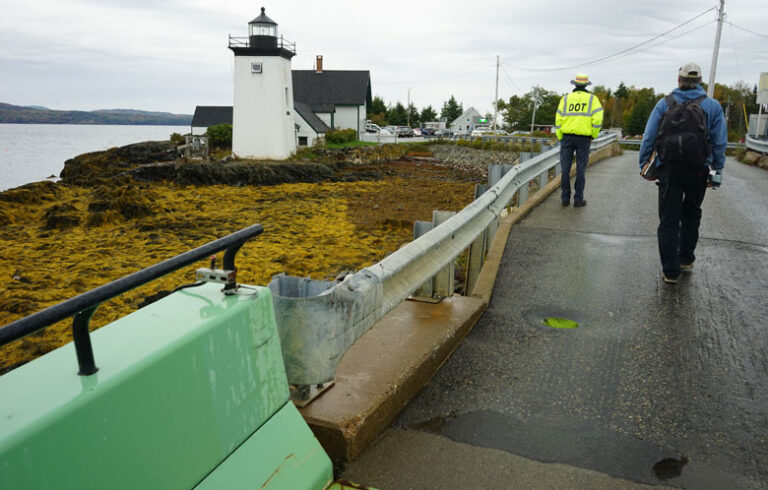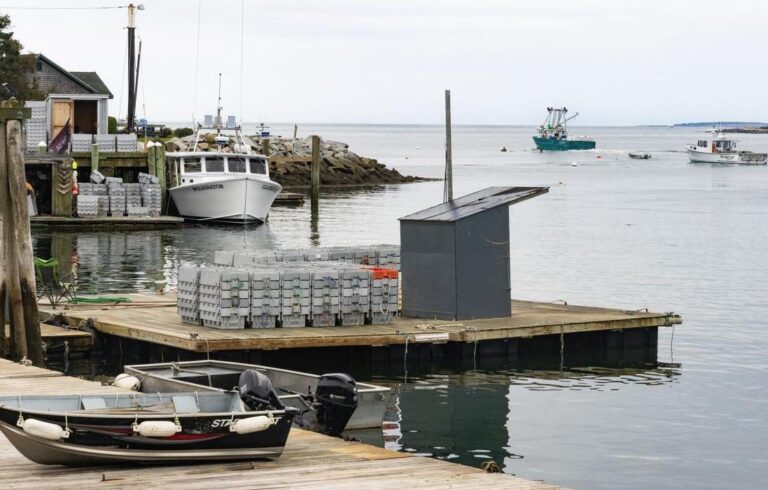The islands are pretty active in October as most of us get ready for winter. This year, summer lingered beyond September and we’re off to a gorgeous beginning of a chore-filled month. The weather is so beautiful that there is no hardship in being outdoors to do the fall jobs.
At our house we begin with the firewood. Bruce has already started filling the woodshed with softwood that has been drying for a year in rows outside. Adjacent are rows of hardwood, cut and split in 2023. They will be moved and stored in another spot to stay dry and convenient on winter nights.
Bruce has devised a clever system for getting two cords of wood into the basement in sizes that are easy to manage. He couldn’t do it without an item that we will utilize all fall—the shrimp tray. At least that’s what locals call it.
Bruce fills the shrimp trays with hardwood and drags them by rope to the cellar door. There he heaves them onto a wooden rail that he built to fit over the bulkhead stairs.
A shrimp tray is a heavy-duty plastic container, 28-inches long, 16-inches wide, and 14-inches high. Kind of like a rugged oversized laundry basket without holes. The handles on each end are designed to allow the trays to be either stacked when full or nested for storage when empty.
On the lobster boat, Bruce uses them to store bait, lobsters, rope, or whatever. On the island you see them by the co-op, near houses, on the floats, near gardens, and near workshops. If you see a lineup of these totes filled with wood in our back yard, here’s what we’re doing with them:
Bruce fills the shrimp trays with hardwood and drags them by rope to the cellar door. There he heaves them onto a wooden rail that he built to fit over the bulkhead stairs. The trays weigh about 75 pounds when filled with hardwood and they gather a fair amount of momentum coming into the basement on a 45-degree angle.
The sound of heavy, hard plastic being thrown onto a wooden ramp and sliding 10 feet across the cement floor is a call to start my job of stacking. I can easily pull the full tote across the smooth floor and soon I am tossing empty totes back up the stairs and out onto the lawn, ready for their next loads.
When we’re finished with the wood, it’s time to gather seaweed for the garden. I haven’t done this in four years so I’m especially committed to it this year.
We’ll pack ten of the empty shrimp trays in the back of Bruce’s truck and drive to a spot where seaweed sits and decomposes at high tide after storms. With pitchforks in hand and boots on our feet we drag the totes to the middle of the seaweed and start loading them.
It’s harder to drag them full, back up over rocks to the truck, but easier to lift them together up over the tailgate. It’s pretty satisfying to be able to get 500 pounds of seaweed in an afternoon.
The shrimp trays will once again get rinsed and stacked but I’ll set aside three that are cracked along the bottom or have holes. These are the trays I’ll use to “make dirt” for containers in my green house.
I’ll fill them halfway from the semi-composted dumping spot at the edge of our woods where leaves, weeds, and grass clippings have gone for years. I’ll add in any leftover soil from summer planters and cover it all with a thick pile of leaves.
I’ll top that with a nice thick layer of seaweed. I’ll water it and stick it in the empty greenhouse for the winter. By spring I’ll stir it up a little, then throw a bag of potting soil on top and I’ll plant some lettuce seeds.
Shrimp trays have been a part of life that I never really thought about until I was trying to come up with a topic for this column while simultaneously stacking wood in the basement. I just took them for granted. I googled the term to try to find more information as to price and availability, but all I could find were offers of shrimp cocktail or the platters on which to serve it!
If you’re experiencing shrimp tray envy from hearing how useful they are, never fear. I persevered. They are called “85-liter fish totes” and are available at Hamilton Marine for $33.99. They also make a great little vehicle for pulling small children around in the snow. Winter is coming!
Barbara Fernald lives on Islesford (Little Cranberry Island). She may be contacted at Fernald244@gmail.com.





